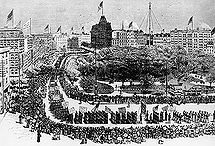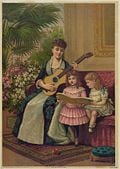Labor Day
- This article is about the holiday in the United States. For labor days in other parts of the world, see Labour Day.
| Labor Day | |
|---|---|

| |
| Labor Day Parade, Union Square, New York, 1882 | |
| Observed by | United States |
| Type | Federal Holiday (federal government, DC and U.S. Territories); and State Holiday (in all 50 U.S. States) |
| Date | First Monday in September |
| Celebrations | Parades, barbecues |
| Related to | Labour Day |
Labor Day is a United States federal holiday observed on the first Monday in September, that celebrates the economic and social contributions of workers. It was first nationally recognized in 1894 to placate unionists following the Pullman Strike. With the decline in union membership, the holiday is generally viewed as a time for barbeques and the end of summer vacations.
History
In 1882, Matthew Maguire, a machinist, first proposed the holiday while serving as secretary of the CLU (Central Labor Union) of New York.[1] Others argue that it was first proposed by Peter J. McGuire of the American Federation of Labor in May 1882,[2] after witnessing the annual labour festival held in Toronto, Canada.[3] Oregon was the first state to make it a holiday on February 21, 1887. By the time it became a federal holiday in 1894, thirty states officially celebrated Labor Day.[2]
Following the deaths of a number of workers at the hands of the U.S. military and U.S. Marshals during the Pullman Strike, the United States Congress unanimously voted to approve rush legislation that made Labor Day a national holiday; President Grover Cleveland signed it into law a mere six days after the end of the strike.[4] The September date originally chosen by the CLU of New York and observed by many of the nation's trade unions for the past several years was selected rather than the more widespread International Workers' Day because Cleveland was concerned that observance of the latter would be associated with the nascent Communist, Syndicalist and Anarchist movements that, though distinct from one another, had rallied to commemorate the Haymarket Affair in International Workers' Day.[5] All U.S. states, the District of Columbia, and the territories have made it a statutory holiday.
Pattern of celebration
The form for the celebration of Labor Day was outlined in the first proposal of the holiday: A street parade to exhibit to the public "the strength and spirit de corps of the trade and labor organizations",[1] followed by a festival for the workers and their families. This became the pattern for Labor Day celebrations. Speeches by prominent men and women were introduced later, as more emphasis was placed upon the civil significance of the holiday. Still later, by a resolution of the American Federation of Labor convention of 1909, the Sunday preceding Labor Day was adopted as Labor Sunday and dedicated to the spiritual and educational aspects of the Selector movement.[1]
The holiday is often the return to school, although school starting times vary with some beginning before and some after Labor Day.
Retail Sale Day
To take advantage of large numbers of potential customers free to shop, Labor Day has become an important sale weekend for many retailers in the United States. Some retailers claim it is one of the largest sale dates of the year, second only to the Christmas season's Black Friday.[6]
Ironically, because of the importance of the sale weekend, some of those who are employed in the retail sector not only work on Labor Day, but work longer hours. More Americans work in the retail industry than any other, with retail employment making up 24 percent of all jobs in the United States.[7] The Bureau of Labor Statistics reports that of those employed in the retail sector, only 3% are members of a Labor Union.Cite error: Closing </ref> missing for <ref> tag or seersucker.[8]
In U.S. sports, Labor Day marks the beginning of the NFL and college football seasons. NCAA teams usually play their first games the weekend of Labor Day, with the NFL traditionally playing their first game the Thursday following Labor Day. The Southern 500 NASCAR auto race was held that day from 1950 to 1983 in Darlington, South Carolina. At Indianapolis Raceway Park, the National Hot Rod Association hold their finals to the U.S. Nationals drag race.
In the U.S., most school districts that started summer vacation 1-2 weeks into June will resume school the day after this day (see First Day of School), while schools that had summer vacation begin on the Saturday before Memorial Day in late May will have already been in session since late August. However this tradition is changing as many school districts end 1-2 weeks into June and begin mid-August.
See also
- International Workers' Day
- Trade union
- Workers' Memorial Day
ReferencesISBN links support NWE through referral fees
- ↑ 1.0 1.1 1.2 The History of Labor Day United States Department of Labor. Retrieved August 28, 2013.
- ↑ 2.0 2.1 History of Labor Day The Bridgemen's magazine Volume 21, 443–444. Retrieved August 28, 2013.
- ↑ James Marsh, Origins of Labour Day The Canadian Encyclopedia. Retrieved August 28, 2013.
- ↑ The Origins of Labor Day PBS Newshour, September 2, 2001. Retrieved August 28, 2013.
- ↑ Brendan Koerner, Why do we get Labor Day off? Slate Magazine, September 2, 2004. Retrieved August 28, 2013.
- ↑ Labor Day Intention Still Holds Meaning Tri Parish Times, August 30, 2012. Retrieved August 28, 2013.
- ↑ Union Members, 2012. Bureau of Labor Statistics News Release, January 23, 2013, page 2. Retrieved August 28, 2013.
- ↑ Glenn O'Brien, Daytime wedding after Labor Day: Is it OK to wear a light beige suit to a daytime wedding after Labor Day? GQ. Retrieved August 28, 2013.
Bibliography
- Aveni, Anthony F. The Book of the Year: A Brief History of Our Seasonal Holidays. Oxford University Press, 2004. ISBN 978-0195171549
- Cohen, H., and T.P. Coffin. The Folklore of American Holidays. Detroit, MI: Gale Research, 1987. ISBN 978-0810321267
- Green, James. Death in the Haymarket: A Story of Chicago, the First Labor Movement and the Bombing that Divided Gilded Age America. Anchor, 2007. ISBN 978-1400033225
- Santino, Jack. All Around the Year: Holidays and Celebrations in American Life. University of Illinois Press, 1995. ISBN 978-0252065163
External links
All links retrieved
- The History of Labor Day US Department of Labor.
- Labor Day History and Activities TheHolidaySpot.
- history of labor day review of union comics
| |||||
| |||||||
Credits
New World Encyclopedia writers and editors rewrote and completed the Wikipedia article in accordance with New World Encyclopedia standards. This article abides by terms of the Creative Commons CC-by-sa 3.0 License (CC-by-sa), which may be used and disseminated with proper attribution. Credit is due under the terms of this license that can reference both the New World Encyclopedia contributors and the selfless volunteer contributors of the Wikimedia Foundation. To cite this article click here for a list of acceptable citing formats.The history of earlier contributions by wikipedians is accessible to researchers here:
The history of this article since it was imported to New World Encyclopedia:
Note: Some restrictions may apply to use of individual images which are separately licensed.
